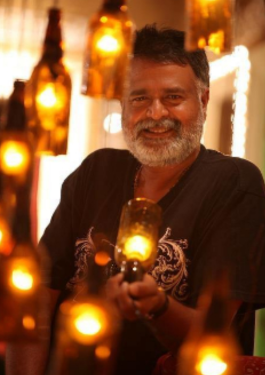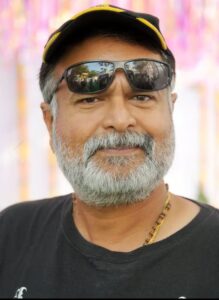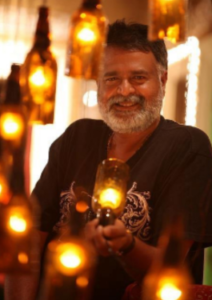
Jayanan Vincent : 100 Films remarkable Journey Part 1
Jan 12 2024
Jayanan Vincent ISC is not just a cinematographer; he is a polyglot of emotions, using his lens to translate the language of the soul across Indian cinema’s diverse landscape. With 100 films and counting, his journey is an ode to the unifying power of the moving image.


Son of the legendary A. Vincent, considered the father of Indian cinematography and elder brother to Ace Cinematographer Ajayan Vincent, Jayanan has inherited more than just a name.
He has won more accolades during his long successful career, inclusive of two Nandi Awards.

SICA is proud to present his Visual Journey through a series of conversation.
1. *Transitioning to Digital:* Your career spans the analog and digital eras of filmmaking. How did the shift to digital impact your approach to cinematography, both technically and creatively?
Good question!
Hmmm… I have to admit that I was a tad overwhelmed and lacked confidence stepping into the digital era.
Although, I did dabble with some digital cameras for TV commercials and a short film in the late 1990’s, I wasn’t able to wrap my head around digital imagery. Luckily, my Canadian Permanent Residency came through around that time and off I went seeking newer pastures.
The digital transition was fast gaining momentum when I was in Canada. In the last quarter of 2001, I joined Baljit Singh Deo, a British stills photographer, editor and director based in Vancouver. He was an amazing visionary and a talented photographer.
The collaboration was rewarding. He hadn’t shot music videos or shorts on film and I hadn’t shot much digital so we went through the learning curve together exchanging visions and thoughts. Thanks to him, I was involved in numerous Punjabi music videos filmed out of Vancouver and had the wonderful opportunity to experiment with the digital media.
‘Jag Jeondeya De Mele’ directed by Baljit Singh Deo was the first Punjabi feature to be filmed in Super35 in the year 2009. It was the culmination of our collaboration. Incidentally, the movie set a bench mark in Punjabi cinema for its visual splendour, music, performances and excellence in direction. We used the Arri 435 ES camera w/Cooke S4i lenses rented from Anand Cine Services, Chennai for schedules in Punjab and Vancouver.

It was during that period, I headed back to various film schools in Vancouver to learn digital cinematography, Avid and Final Cut Pro editing. This new learning program in the Western world enhanced my understanding of the technical aspects of digital filmmaking. A study that put me back on tracks with new found confidence and knowledge to face the challenges ahead.
I’ve always regretted the decision to turn down film schools recommended by my father during my rudimentary days. Oh well! Everyone makes bad choices and I made a terrible one. So for the rookies, my mantra would be ‘go to a film school’ and you’ll never regret the decision.
In 2009, after an eight year hiatus from filmmaking in India, I embarked on an ambitious return to the Telugu film industry with the project, ‘Love 4 Ever’ filmed in New Zealand with Kowa Anamorphic Lenses on Kodak negative. I’d proudly state that that movie was a visual treat and one of my best works to date but alas gathering dust somewhere in a film laboratory. ‘Love 4 Ever’ was followed by a slew of other Telugu features on film and digital until 2015.
What amazed me was the choice of lenses, filters and lighting and the post production facilities available in Hyderabad to the present day cinematographers to create wonderful images and enhance the same in post. I consider the newer bunch of cinematographers lucky because of the tools readily available to fulfill their creative urge.
I enjoyed my second innings in Telugu wherein I put into use my best creative perspective, rich experience and newly acquired knowledge. The outcome was some successful movies and the rest not so. I accept it’s all part of the rollercoaster ride called show biz.

2. *Pioneering Experimentation:* You were one of the first to use Tube lights in South Indian cinema. Can you tell us about the challenges and rewards of this experiment in “New Delhi”?
I’m not quite sure if I was the first one to use tube lights/fluorescent bulbs in South Indian cinema. But yes, I did film with the tube lights/fluorescent bulbs for some sequences in the multi-storeyed buildings of Hindustan Times. ‘New Delhi’ was the first Malayalam feature to be filmed in the capital, New Delhi, in 1987.

I still remember the eerie silence after the writer, Late Dennis Joseph, narrated the story of ‘New Delhi’. (I lit a cigarette to ease the tension and passed the pack to Dennis. We’ve known each other and worked alongside since 1985). He was a maverick at weaving plots and exploring uncharted territories. The sequences conceived were unique and never attempted in this massive scale in Malayalam cinema. And the perfect director to bring it to fruition was the master craftsman, Joshi with the enthusiastic and daring producer, Joy Thomas of Jubilee Productions, who ‘risked it all’ to make it happen.
As part of the pre-production, I flew to Bombay (now Mumbai) to test/rent a camera with high speed anamorphic lenses. Almost 50 % of the movie had night scenes and I wished to film on wide apertures with minimal lighting.
My preferred stock was Kodak but unfortunately due to budgetary constraints chose Fujifilm. Kowa and Todd AO lenses were available in Madras but none were nocturnal. Todd AO’s were bulkier and therefore my last choice. (Cineovision lenses with wider apertures were pre-booked for the bigger budget Telugu features). So the obvious choice was Nippon Scope prime lenses. Of course, I did use Kowa lenses for the B cam and car rig shots.
Central Camera Company, now defunct, was my go to haven for lights and accessories. Mr. M. L. Sharma spearheaded the institution manufacturing lights, stands and accessories for film and stage lighting but mostly for export. Sharma Ji and I have been acquainted for the past 4 odd years. I was instrumental in setting outdoor units for Late director I. V. Sasi and Geo Movies. It’s another story for another time.
Anyways, Sharma Ji had a custom designed harness with a mount for an Arriflex camera to capture handheld shots with extra stability. I added this to my armoury of camera gear. Sharma Ji also manufactured the HMI lamp heads installed with imported lamp holders and ballasts. I was able to rent a few 2500W, 1200W and 575W HMI lights from a trusted client of his.
Hindustan Times, New Delhi was the press we filmed. It stood in for the movie’s, ‘New Delhi Diary’ press. Most of filming at the press was at night when HT rolled out the Late City edition for New Delhi city. Time restraints and deadlines added to the pressure on set. The interiors were lit with fluorescent tubes especially their spanking new computer centre. There was no way to run cables from the generator to power up the lights in the upper floors of the building. And the greater risk was to blow the fuse using our lighting off the electrical power grid of the building. The only option was to film with the available lighting. I used the Fuji High Speed (Tungsten) balanced stock with a Wratten 85 to eliminate the bluish/green light to capture a desirable image. The other nightmare was the pulsating bars on the computer screens. To overcome this problem, I used the crystal controlled motor on the Arriflex IIC BV camera turning it on and off intermittently to place the pulsating bar either to the top or bottom of the computer screens. Primitive as it may sound the experiment worked.
Hurray! we filmed under duress but achieved the desired results.


3. *Capturing Candid Moments:* Your candid shots of the Republic Day parade in a film is iconic. How did you capture such a raw and dynamic moment without disrupting the event?
There was a sense of excitement and anticipation as I woke up in the early hours of January 25, 1987. It was bitterly cold and foggy, a typical wintry morning in New Delhi.
I recollected watching the Republic Day Parade on television for years on end. I adored the smooth dissolves, the picture perfect shots and the great presentation. As shots of the Tricolours flashed on the screen, a sense of pride and patriotism swelled in me. The vibrant colours of the dancers, the crisp uniformed army officers and the enthralling music of the military band coupled with the majestic display of India’s military might and the splendid fly past of the Indian Air Force was all so overwhelming. These images were imprinted in my memory.
A select crew was picked to film the parade. Shekar Joseph, my associate cinematographer and I were herded into a vehicle with the camera crew. The second camera crew followed us. We headed to a designated area near Rajpath. The fog was dense. The visibility was low and made driving conditions challenging, for filming too. Yet, we drove into heavy fog to execute our mission.
The fun fact was we were in New Delhi without filming permits. All we had was the blessings of the then Kerala Govt headed by Late Chief Minister K. Karunakaran. As a stroke of luck, our producer, Joy Thomas had a chance meeting with none other than the young, dynamic personal secretary of the Late Prime Minister. Mr. Rajiv Gandhi. The concerned gentleman hailed from the same hometown as Joy Thomas.
QED: It was a battle half won.
Thanks to the secretary. Two VIP passes were issued for seating in the press enclosure. The miracle of five loaves of bread and two fish was religiously followed. We multiplied into dozens in no time in the enclosure with our two passes.
We quickly blocked our shots and began filming the ensuing scene as soon as the parade began. Again, we didn’t have the luxury of lighting gear or reflectors. We had to film discreetly and not attract too much attention for fear of being shut down. The fog dissipated as the sun shone through, emitting a veiled soft light. Fortunately, we had the actors half lit by the sunlight for the scenes with literally zero fill. Nature did the wrap around fill.
We filmed with an Angenieux zoom mounted A cam and primes on the B cam loaded with Fujifilm 8511 125T with Wratten 85B & 85N3. Although, I don’t quite recall the exact exposure settings, I knew we didn’t carry exposure meters on set especially the spot meter as it resembled a fire arm. (Security was at an all time high in the Capital due to turmoil in our neighbouring island in the South.)So apertures were set by eye judgement after quick consultations with my associate, Shekar Joseph.
Once the scene was filmed, we had to hustle for spots designated for the press and TV cameras on a 20 foot gallery to ensure we had the best uninterrupted views to capture the parade. ‘Early bird catches the worm’ as the proverb goes.
Cans and cans of 400 feet film were loaded into the magazines and constantly despatched to both the cameras. We exposed a good lot of footage of the parade presenting the editor and director options to choose the best shots.
Shekar Joseph, now an established cinematographer, operated the B cam. First AD, GK (Govindan Kutty) coordinated between the A & B cams to indicate what the directorial team required. He’s seen alongside Joy Thomas in the parade scene in the movie.
Murugan, a senior cinematographer, was also part of the crew. He was Joshi’s ‘Man Friday’ and handled director’s personal video camera which served as our go to for continuity checks and playback of the footage filmed. Remember back in the day, we had no monitors and no video village. We relied heavily on the video footage shot by Murugannan. He replicated the exact frame and composition as best as he could by viewing the A cam and staying fairly close to the lens. His footage, though, had a slight parallax error but we couldn’t care less.
(Murugannan finally turned cinematographer for a Dennis Joseph directed movie in Malayalam.)

JAYANAN VINCENT ISC 100 Films remarkable Journey Part 2 …..continues next article stay tuned!
Article drafted by
CJ Rajkumar
Author/Cinematographer
